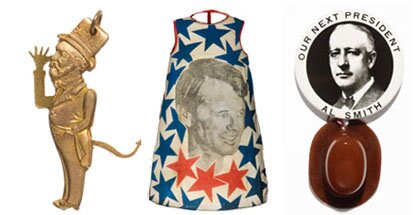
As the election day draws closer, it is clear that Obama vs. McCain will be one of the most memorable election battles in our country for many.
In New York City there are currently several exhibitions that explore numerous aspects of presidential campaign history. “Campaigning for President: New York and American Election” at the Museum of the City of New York looks at how the city has affected the presidential election since George Washington defeated John Adams in 1789. Aside from the show’s link to New York’s influence it features the most extensive collection of memorabilia. The exhibit displays hundreds of buttons, banners, hats, flags, posters, newspapers, buckles, signs neckties and knick-knacks dating back to the 19th century from the personal collection of Jordon M. Wright.
While considering the vast array of items, it is easy for you to make some correlations to today’s campaign paraphernalia, with the button being by far the most popular vehicle for messaging up until today.
However, it’d hard to over look some of the outrageous campaign strategies that our presidential candidates have produced in attempt to win the presidency.
For instance, vistors to the museum can reflect on a brochures messaging for Governer Al Smith’s 1928 campaign that asks, “Can a Catholic Be President?”, which makes a plea for religious tolerance.
And in a striking indication of how little has changed, questions about personal conduct, moral rectitude and charges of adultery have continued throughout the history of presidential campaigns. Ridicule and smear campaigns have a common place in our history and with race as a larger issue in this year’s campaign perhaps more than any time in our history, the show exhibit takes us back to 1896 with a William McKinley doll. The doll, when flipped over, revealed an African-American baby. An illusion to the allegation that McKinley had fathered an illegitimate interracial child.
One might wonder what the strategists behind these campaigns were thinking and how the notion of “politically correct” was ever connected to the world of politics.
Still, most of the campaign material on display was designed to promote the candidates and were limited only by parties imagination. There is a parasol promoting Bryan/Stevens (1900); LBJ for the USA matchbook cover; a straight razor for Blaine/Loga (1884); a pair of ladies gloves patterned with the slogan “I like Ike”.
Although industrial designers may cringe at the idea of some of these items, especially at a time of social consciousness around function and excess, I still recommend this show to everyone to see for yourself.
These objects – from posters to paper dresses are a fascinating, humorous and absurd representation on the strategy, branding, and communication design that has shaped and influenced the American culture.
Until Nov 4th at the Museum of the City of New York, or look for the collection to take eventual residency at it’s permanent home at the “Museum of Democracy”.